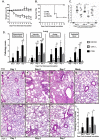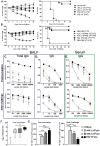Protective immunity and safety of a genetically modified influenza virus vaccine
- PMID: 24927156
- PMCID: PMC4057169
- DOI: 10.1371/journal.pone.0098685
Protective immunity and safety of a genetically modified influenza virus vaccine
Abstract
Recombinant influenza viruses are promising viral platforms to be used as antigen delivery vectors. To this aim, one of the most promising approaches consists of generating recombinant viruses harboring partially truncated neuraminidase (NA) segments. To date, all studies have pointed to safety and usefulness of this viral platform. However, some aspects of the inflammatory and immune responses triggered by those recombinant viruses and their safety to immunocompromised hosts remained to be elucidated. In the present study, we generated a recombinant influenza virus harboring a truncated NA segment (vNA-Δ) and evaluated the innate and inflammatory responses and the safety of this recombinant virus in wild type or knock-out (KO) mice with impaired innate (Myd88 -/-) or acquired (RAG -/-) immune responses. Infection using truncated neuraminidase influenza virus was harmless regarding lung and systemic inflammatory response in wild type mice and was highly attenuated in KO mice. We also demonstrated that vNA-Δ infection does not induce unbalanced cytokine production that strongly contributes to lung damage in infected mice. In addition, the recombinant influenza virus was able to trigger both local and systemic virus-specific humoral and CD8+ T cellular immune responses which protected immunized mice against the challenge with a lethal dose of homologous A/PR8/34 influenza virus. Taken together, our findings suggest and reinforce the safety of using NA deleted influenza viruses as antigen delivery vectors against human or veterinary pathogens.
Conflict of interest statement
Figures







References
-
- Lamb RA, Krug RM (2007) Orthomyxoviridae: the viruses and their replication. In: B.N F, editor. Virology. 5 ed. Philadelphia: Lippincott-Raven. pp. 1647–1690.
-
- Rollier CS, Reyes-Sandoval A, Cottingham MG, Ewer K, Hill AV (2011) Viral vectors as vaccine platforms: deployment in sight. Curr Opin Immunol 23: 377–382. - PubMed
-
- Rocha CD, Caetano BC, Machado AV, Bruna-Romero O (2004) Recombinant viruses as tools to induce protective cellular immunity against infectious diseases. Int Microbiol 7: 83–94. - PubMed
Publication types
MeSH terms
Substances
LinkOut - more resources
Full Text Sources
Other Literature Sources
Medical
Research Materials

